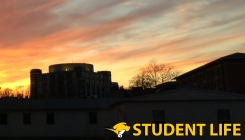Learning at the Native American heritage festival
Andrew Mayn
Contributing Writer
Another series of ongoing diversity events helps foster sensitivity and respect within the UMBC community.
A campus that prizes diversity as much as UMBC challenges students to open their eyes, ears and minds to the experiences of others who are different from themselves. There are few places where this spirit is as evident as the 2014-2015 UMBC Celebrates Diversity event series.
November is Native American history month, and to mark the occasion, The Mosaic Center, in cooperation with other UMBC institutions such as The Women’s Center and University Health Services, organized a heritage fair on Commons Main Street. The event was complete with food, conversation and plenty of information.
Chartwell’s provided a sweet and crunchy harvest apple salad chock full of apple, pomegranate and almonds in a cinnamon yogurt sauce while the University Bookstore had several titles on the experiences of Native Americans on sale.
An underlying theme of the event seemed to be that the best representatives of a particular culture are the members themselves, rather than third parties. Though it was interesting to note the limited presence of Native American students at the event. Organizers were aware of this and, to avoid the risk of misrepresenting an already under-represented group, some focus was dedicated to the phenomenon of cultural appropriation as it relates to Native American communities.
Jess Myers, acting director of The Women’s Center, drew on her previous experiences at Colorado State University to explain.
“At Colorado State … there was a much larger Native American student population and staff and faculty population, and there was actually a Native American cultural center. There was a lot of visual representation of Native American people and their experiences and their values and culture in a different way than is experienced here at UMBC,” Myers said.
Under-representation and cultural appropriation, as Myers suggested, is problematic. She said, “We don’t have people … that we know and care about to hold us accountable in some ways. It becomes this kind of thing where ‘It doesn’t apply to me’ or ‘It doesn’t apply to my friends’ or ‘I don’t know people who this impacts personally’ and so that’s why, at least in The Women’s Center, we took this fair as an opportunity for us to look a little bit more about cultural appropriation.”
Jasmine Malhotra, a graduate student in the applied sociology program, commented on the responsibility that comes with organizing such an event. With regards to accurately portraying Native American culture, she said, “We had to be careful and really do our research. We really don’t know because we have no one from that background.”
Issues of culture and appropriation, such as those explored at the fair, often evoke strong feelings. Many people, for example, feel very passionately one way or another about the name of Washington D.C.’s football team: the Washington Redskins. As strong as these feelings may be, however, they don’t have to result in a breakdown of communication.
To this end, Daniel Willey, a sophomore studying gender and women’s studies, introduced Critical Social Justice’s newest initiative, Brave Spaces.
“Brave Spaces is about opening up to being vulnerable and stepping out of your comfort zone so that we can learn more from other people,” Willey said.
Fortunately, programs such as the heritage fairs continue to provide students plenty of opportunities to do so.



